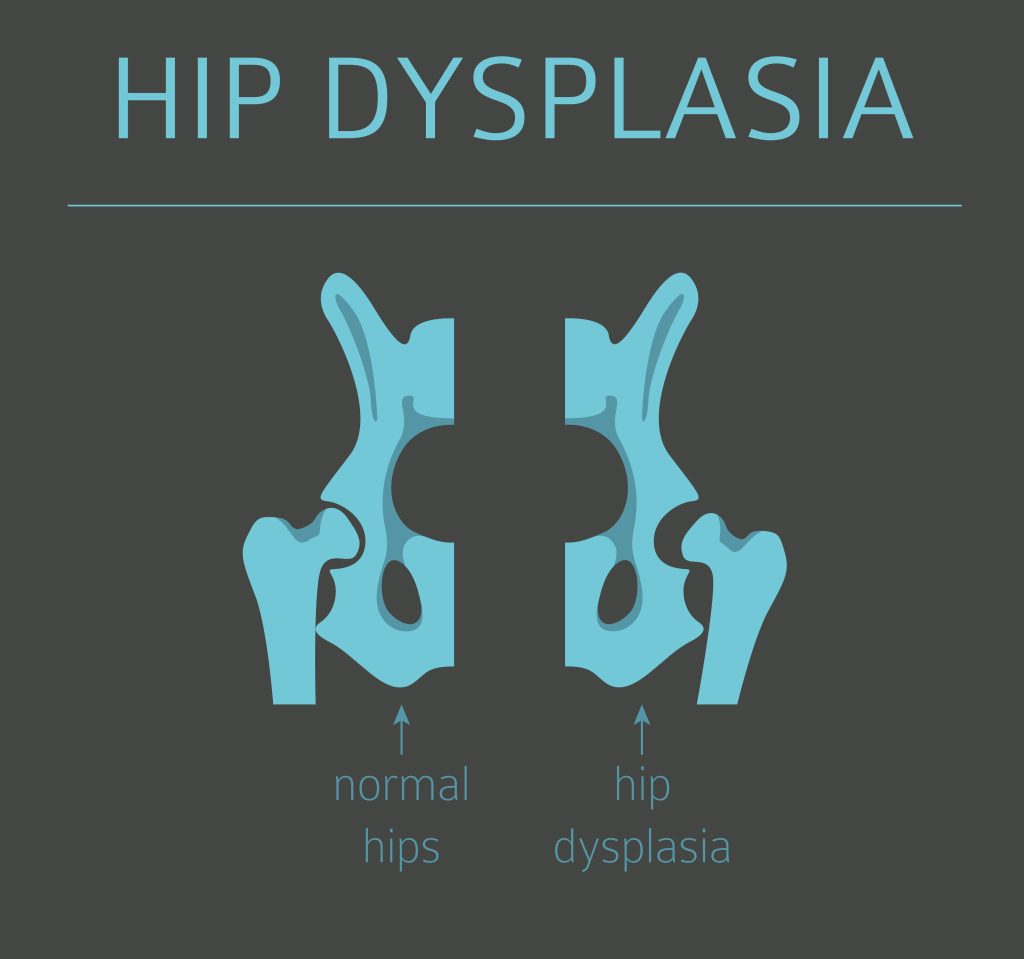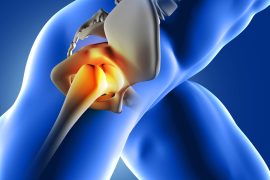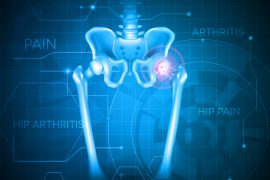Introduction
Hip dysplasia is a medical term for a common congenital condition that affects the hip joint, causing it to develop abnormally. The hip joint is critical for walking, running, and jumping. It is one of the largest weight-bearing joints. In hip dysplasia, the hip joint socket does not fully cover the ball of the upper thighbone, leading to instability and joint damage over time. This condition can cause significant discomfort and impact quality of life, especially if left untreated. With improper development, the hip joint becomes partially or completely dislocated, increasing the risk of arthritis and joint deterioration later in life. It’s a common condition and affects individuals of all ages, from infants to elderly adults. Those with hip dysplasia are typically born with this condition
Symptoms of Hip Dysplasia
The symptoms of hip dysplasia can vary based on the severity of the condition and by age group ranging from mild to severe. Some common symptoms include:
- Pain or discomfort in the hip joint
- Limping or favouring one leg over the other
- Decreased range of motion in the hip joint
- Popping or clicking sounds in the hip joint
- A waddling gait or sway in the hip region
It’s important to note that some individuals experience no symptoms at all, thus, making it essential to receive regular check-ups to monitor the health of the hip joint.
In the case of infants, doctors check for signs of hip dysplasia shortly after birth and during follow-up visits. Usually, you will notice one leg is shorter than the other and find one hip less flexible during a diaper change. Or when the child starts walking, they may develop a limp. A soft brace usually corrects the problem of hip dysplasia if it is diagnosed in early infancy.
In mild cases of hip dysplasia, symptoms may not start until a person is a teenager or young adult, damaging the cartilage lining the joint, and hurting the soft cartilage (labrum) lining the socket, causing a hip labral tear. It can result in activity-related groin pain and a sensation of hip instability. Surgery is usually recommended to move the bones into the proper positions for smooth joint movement.
Causes of Hip Dysplasia
The hip joint is formed from soft cartilage at birth, gradually becoming bone. The ball and socket must fit correctly as they shape each other. If the ball isn’t properly seated in the socket, the socket will be shallow and not fully formed around the ball. Crowding in the womb during the final month before birth can cause the hip joint ball to move out of place, leading to a shallower socket. The following factors may cause hip dysplasia-
- First pregnancy,
- Large baby, or
- Breech presentation.
Risks and Complications of Hip Dysplasia
Hip dysplasia has a genetic tendency and is more prevalent in girls. The risk of developing hip dysplasia increases in babies born in the breech position and those tightly swaddled with straight hips and knees. Hip dysplasia can increase the risk of developing other hip problems later in life, including arthritis and joint deterioration. These conditions can lead to significant pain and disability and may require surgery to correct. Hip dysplasia can also cause a person to develop a limp or walk with an awkward gait, leading to further musculoskeletal problems like arthritis and other long-term joint problems if left untreated.
Treatment Options for Hip Dysplasia
The treatment options for hip dysplasia may vary depending on the severity of the condition and the patient’s age. For children, treatment may include physical therapy and bracing to help improve hip alignment and strengthen the muscles surrounding the joint.
For adults, treatment options may include non-surgical options such as physical therapy, weight management, and pain management. Surgery may be recommended in more severe cases to correct the hip joint and prevent future damage.
- Prevention of Hip Dysplasia
- There is no surefire way to prevent hip dysplasia. Still, some steps can reduce the risk of developing this condition. These include:
- Maintaining a healthy weight
- Engaging in regular physical activity to strengthen the muscles surrounding the hip joint
- Avoiding high-impact activities that put excessive stress on the hip joint
- Wearing proper footwear to help maintain proper hip alignment
Conclusion
Hip dysplasia is a common congenital condition that affects the hip joint and can lead to significant discomfort and disability if left untreated. Treatment options for hip dysplasia vary based on the severity of the condition and the patient’s age. They may include physical therapy, bracing, weight management, and surgery. By taking steps to maintain a healthy weight, engage in regular physical activity, avoid high-impact activities, and wear proper footwear, individuals can reduce their risk of developing hip dysplasia and maintain a high quality of life. You must have regular check-ups with a healthcare provider to monitor the health of the hip joint and address any issues that may arise.
FAQs
Q: What is hip dysplasia?
Hip dysplasia is a congenital condition in which the hip socket is shallow that does not fully cover the ball, causing instability in the joint and increasing the risk of arthritis and joint deterioration.
Q: Who is at risk for hip dysplasia?
Anyone can develop hip dysplasia, but it is common in individuals with a family history of the condition, women, and people with certain genetic conditions.
Q: What are the symptoms of hip dysplasia?
The symptoms of hip dysplasia can include pain or discomfort in the hip joint, limping or favouring one leg over the other, decreased range of motion in the hip joint, popping or clicking sounds in the hip joint, and a waddling gait or sway in the hip region.
Q: How is hip dysplasia diagnosed?
Hip dysplasia is typically diagnosed through a physical examination and imaging tests, such as X-rays or MRI scans.
Q: How is hip dysplasia treated?
Treatment options for hip dysplasia, depending on the severity of the condition and the patient’s age may include physical therapy, bracing, weight management, and surgery.
Q: Can hip dysplasia be prevented?
While hip dysplasia cannot be prevented, individuals can reduce their risk of developing the condition through weight management and regular physical activity, avoiding high-impact activities and wearing proper footwear.
Q: Can hip dysplasia cause long-term complications?
If left untreated, hip dysplasia can increase the risk of developing other hip problems later in life, including arthritis and joint deterioration, which can cause significant pain and disability.
Q: When should I see a doctor for hip dysplasia?
If you are experiencing symptoms of hip dysplasia, such as pain or discomfort in the hip joint or a limp or waddling gait, it is important to see a doctor. Regular check-ups with a healthcare provider can also help monitor the health of the hip joint and address any issues that may arise.
References :





Comments are closed.